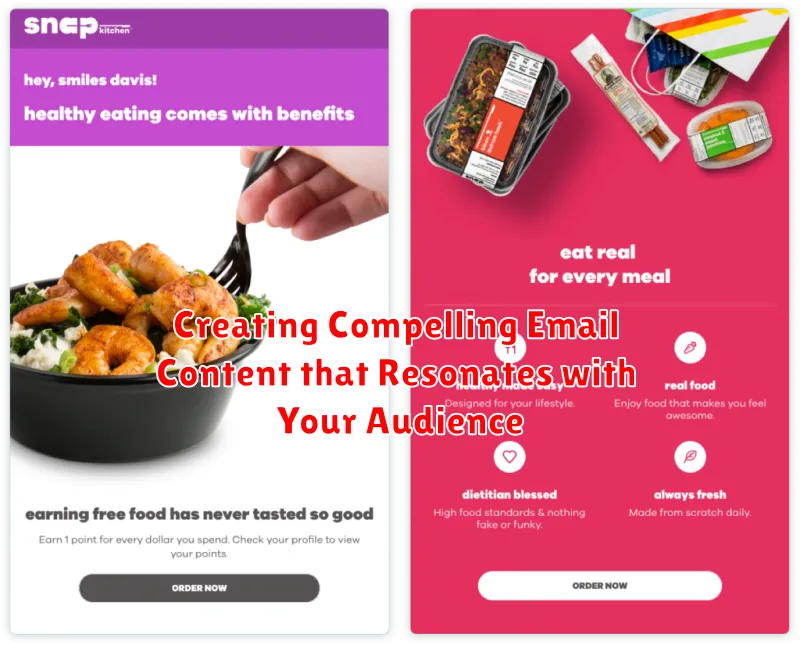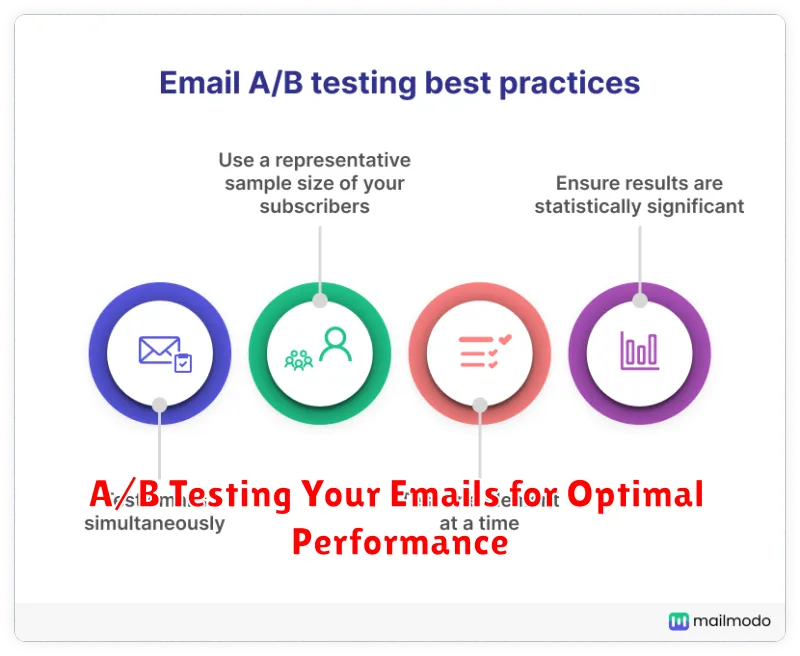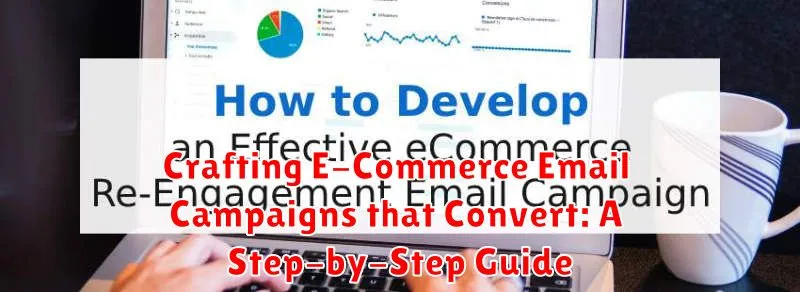In the competitive landscape of online retail, e-commerce email marketing remains a potent tool for driving sales and cultivating customer loyalty. Crafting high-converting email campaigns is essential for maximizing your return on investment and achieving e-commerce success. This comprehensive guide will provide a step-by-step approach to developing e-commerce email campaigns that convert, covering everything from strategic planning and segmentation to compelling content creation and performance analysis. Whether you’re a seasoned marketer or just starting out, this guide offers valuable insights to elevate your email marketing strategy and achieve tangible results.
From welcome emails and abandoned cart reminders to promotional offers and post-purchase follow-ups, effective e-commerce email campaigns nurture customer relationships throughout the entire sales funnel. This guide will delve into the key elements of a successful e-commerce email campaign, including targeted segmentation, personalized messaging, compelling calls to action, and data-driven optimization. Learn how to leverage email automation to streamline your workflow and deliver the right message to the right customer at the right time. By implementing the strategies outlined in this guide, you can transform your e-commerce email marketing into a powerful engine for growth and profitability.
Defining Your Target Audience and Email Marketing Goals
Before launching any email campaign, it’s crucial to define your target audience and establish clear marketing goals. Understanding your audience is the foundation of effective email marketing. Without this knowledge, your messages will likely miss the mark.
Start by identifying your ideal customer. Consider demographics like age, gender, location, and income level. Dive deeper into their psychographics: their interests, values, pain points, and online behavior. Where do they spend their time online? What are their purchasing habits?
Once you have a clear picture of your target audience, define your email marketing goals. Are you aiming to increase brand awareness, drive sales, boost website traffic, or cultivate customer loyalty? Specific, measurable, achievable, relevant, and time-bound (SMART) goals will guide your strategy and enable you to track your progress effectively.
For example, a SMART goal might be: “Increase sales by 15% in the next quarter through targeted email promotions.” This provides a clear objective and a timeframe for achieving it.
Building a High-Quality Email List Organically
A high-quality email list is the foundation of successful email marketing. Organic list building focuses on attracting genuinely interested subscribers, resulting in higher engagement and conversions. Avoid purchasing lists, as this can harm your sender reputation and lead to low-quality leads.
Offer valuable incentives. Encourage sign-ups by providing compelling reasons for customers to share their email addresses. Consider offering exclusive discounts, free shipping, early access to sales, or downloadable resources like e-books or checklists.
Optimize your website for opt-ins. Place strategically positioned sign-up forms throughout your site. Use clear call-to-actions and concise language explaining the benefits of subscribing. Pop-up forms can be effective, but ensure they are not intrusive and offer easy exit options.
Leverage social media. Promote your email list and its benefits across your social media channels. Run contests or giveaways that require email sign-ups as an entry method. Share valuable content that directs users to your website’s sign-up forms.
Creating Compelling Email Content that Resonates with Your Audience

Crafting effective email content is crucial for driving conversions. Relevance is key. Your emails should speak directly to your audience’s needs and interests. Begin with a compelling subject line that grabs attention and accurately reflects the email’s content. Avoid misleading subject lines.
Personalization is equally important. Address recipients by name and segment your list to tailor content to specific demographics or purchase history. This creates a more engaging experience and fosters a sense of connection.
Your email’s body should be concise and easy to read. Use short paragraphs, bullet points, and strong calls to action. Clearly communicate the value proposition and highlight the benefits of your products or services. Strong visuals can enhance engagement, but ensure they are optimized for email clients and load quickly.
Finally, always proofread your emails carefully for any typos or grammatical errors. A polished and professional email reflects well on your brand and builds trust with your audience.
Choosing the Right Email Marketing Platform for Your Business
Selecting the right email marketing platform is crucial for successful e-commerce campaigns. The platform you choose will be the engine driving your email strategy, so careful consideration is essential.
Factors to consider include scalability, pricing, integrations with existing systems, and available features.
Key Features to Look For:
- Automation Capabilities: Automated email sequences, triggered emails, and abandoned cart reminders are essential for converting leads.
- Segmentation Tools: Effectively segmenting your audience allows for targeted messaging and higher conversion rates.
- A/B Testing Functionality: Experiment with different subject lines, content, and calls to action to optimize your campaigns.
- Reporting and Analytics: Track open rates, click-through rates, and conversions to understand what’s working and what needs improvement.
- Deliverability Rate: A high deliverability rate ensures your emails reach your subscribers’ inboxes, not their spam folders.
Evaluate various platforms and consider your current needs and future growth. Choosing a platform that can adapt with your business is a wise investment.
Segmenting Your Email List for Targeted Campaigns
Segmentation is key to maximizing the effectiveness of your email marketing efforts. A generic email blast rarely resonates with everyone on your list. By dividing your subscribers into smaller, more homogenous groups, you can tailor your messaging to specific interests and needs, resulting in higher engagement and conversions.
Start by identifying key segmentation criteria relevant to your business. These could include demographics (age, location, gender), purchase history (products purchased, average order value), website behavior (pages viewed, products added to cart), and email engagement (open rates, click-through rates).
Common segmentation examples include:
- New subscribers vs. loyal customers
- Customers who abandoned their carts
- Customers who purchased specific product categories
- High-value customers
Once you’ve segmented your list, craft targeted email campaigns that address the specific characteristics of each segment. For example, send a welcome series to new subscribers, offer personalized product recommendations based on past purchases, or remind customers about abandoned cart items.
Automating Your Email Marketing Workflow
Automation is key to scaling your email marketing efforts. By automating key processes, you free up time and resources to focus on strategy and content creation.
Start by identifying repetitive tasks. Welcome emails, abandoned cart reminders, and post-purchase follow-ups are prime candidates for automation.
Email marketing platforms offer powerful automation features. Use them to create automated workflows triggered by specific customer actions or timed events.
For example, set up a welcome series triggered by a new subscriber joining your email list. This automated sequence could deliver a welcome message, introduce your brand, and showcase your best-selling products.
Similarly, configure abandoned cart emails to remind shoppers of items left behind and incentivize completion with a discount code. Automating these processes ensures timely communication without manual intervention.
A/B Testing Your Emails for Optimal Performance

A/B testing is crucial for maximizing your email campaign’s effectiveness. It involves comparing two versions of an email to see which performs better. By testing individual elements, you can pinpoint what resonates with your audience and drives conversions.
Key elements to A/B test:
- Subject lines: Test different wording, length, and emojis to see what grabs attention.
- Email copy: Experiment with different messaging, tone, and calls to action.
- Send times: Determine the optimal time to reach your audience’s inbox.
- From name: Test using a personal name versus your brand name.
- Layout and design: Compare different visuals and formatting.
Tips for effective A/B testing:
- Test one element at a time for clear results.
- Use a statistically significant sample size.
- Analyze your results and implement the winning variations.
- Continuously test and iterate to optimize performance.
Analyzing Email Campaign Metrics and Making Data-Driven Decisions
Analyzing email campaign metrics is crucial for understanding what’s working and what’s not. This data-driven approach empowers you to refine your strategies and improve your return on investment (ROI).
Key metrics to track include:
- Open Rate: The percentage of recipients who opened your email. A low open rate might indicate issues with your subject line or sender name.
- Click-Through Rate (CTR): The percentage of recipients who clicked on a link within your email. This metric reflects the effectiveness of your email content and call to action.
- Conversion Rate: The percentage of recipients who completed a desired action, such as making a purchase. This is arguably the most important metric for e-commerce.
- Bounce Rate: The percentage of emails that were not delivered. A high bounce rate can negatively impact your sender reputation.
- Unsubscribe Rate: The percentage of recipients who unsubscribed from your email list. A high unsubscribe rate can signal problems with your content or sending frequency.
By regularly monitoring these metrics and conducting A/B tests, you can identify trends, understand customer behavior, and optimize your email campaigns for maximum impact.
Staying Compliant with Email Marketing Regulations
Maintaining legal compliance is crucial for successful email marketing. Failing to adhere to regulations can result in penalties and damage your brand’s reputation. This section outlines key aspects of staying compliant.
Key Regulations and Considerations
Familiarize yourself with the following:
- CAN-SPAM Act (US): This act establishes requirements for commercial email, including honoring opt-out requests and providing accurate sender information.
- GDPR (EU): The General Data Protection Regulation impacts how you collect, store, and use personal data, including email addresses, from EU citizens. Explicit consent is often required.
- CASL (Canada): Canada’s anti-spam legislation requires consent for sending commercial electronic messages.
- Privacy Policies: A clear and accessible privacy policy is essential. It should explain how you collect, use, and protect subscriber data.
Best Practices for Compliance
Implement these practices to help maintain compliance:
- Obtain explicit consent: Clearly explain what subscribers are signing up for and how you will use their data.
- Honor unsubscribe requests promptly: Provide a clear and easy unsubscribe mechanism in every email.
- Identify yourself clearly: Use a recognizable “From” name and address.
- Provide physical address information: Include your business’s physical address in your emails.

